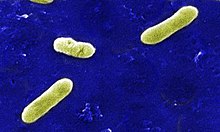
Back سعال الكلاب Arabic Инфекциозен трахеобронхит при кучетата Bulgarian Peswch cenel Welsh Zwingerhusten German Tos de la perrera Spanish Kennelköha Estonian Kennelyskä Finnish Toux de chenil French Casacht chonchró Irish שעלת המכלאות HE


Kennel cough (also "canine infectious respiratory disease" (CIRD), "canine infectious respiratory disease complex" (CIRDC) or "canine infectious tracheobronchitis" (CIT)) is an upper respiratory infection affecting dogs.[1] There are multiple causative agents, the most common being the bacterium Bordetella bronchiseptica (found in 78.7% of cases in Southern Germany), followed by canine parainfluenza virus (CPIV; 37.7% of cases), and to a lesser extent canine coronavirus (9.8% of cases).[2] It is highly contagious;[3] however, adult dogs may display immunity to reinfection even under constant exposure.[4] Kennel cough is so named because the infection can spread quickly among dogs in the close quarters of a kennel or animal shelter.
Viral and bacterial causes of canine cough are spread through airborne droplets produced by sneezing and coughing. These agents also spread through contact with contaminated surfaces. Symptoms begin after a several-day incubation period post-exposure,[3] and in most cases will clear up on their own. However, in young puppies or immunocompromised animals, mixed or secondary infections can progress to lower respiratory infections such as pneumonia.[5]
- ^ Crawford, Cynda (September 26, 2005). "Media Briefing on Canine Influenza". Media Relations, Centers for Disease Control and Prevention. Archived from the original on October 15, 2011. Retrieved 2012-01-24.
- ^ Cite error: The named reference
Schulz_2014was invoked but never defined (see the help page). - ^ a b Ettinger, Stephen J.; Feldman, Edward C. (1995). Textbook of Veterinary Internal Medicine (4th ed.). W.B. Saunders Company. ISBN 0-7216-6795-3.
- ^ Bemis, DA; Carmichael, LE; Appel, MJ (April 1977). "Naturally occurring respiratory disease in a kennel caused by Bordetella bronchiseptica". The Cornell Veterinarian. 67 (2): 282–293. PMID 870289.
- ^ Cite error: The named reference
Sherding G. 2006was invoked but never defined (see the help page).